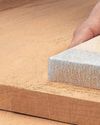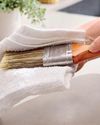CONCRETE CREATIONS: A guide to working with cement
The Home Handyman
|January/February 2025
With the right tools, techniques, and a little know-how, working with cement can be straightforward and incredibly rewarding.
-

This guide will walk you through everything you need to know to get started with cement in your DIY creations.
Choosing the right cement for your project
Understanding the type of cement that suits your project is the first step in ensuring success. Cement comes in several forms, each suited to specific uses.
General-purpose cement is the most commonly used and is perfect for everyday projects like planters, coasters, and small decorative items. It provides a good balance of strength and ease of use, making it ideal for beginners.
Quick-setting cement is excellent for projects where time is a constraint, such as repairs or small crafts. This type of cement sets much faster than traditional options, often within minutes. However, its quick curing time means you need to work efficiently and prepare everything in advance.
Coloured cement can add a creative flair to your work.
With pigments blended into the mix, it's possible to achieve vibrant or subtle hues to match your style. This type of cement is particularly effective for decorative items like tiles, stepping stones, or garden ornaments.
It's always a good idea to read the packaging carefully, as it will provide important information on the cement's working time, strength, and recommended uses. Selecting the right type for your project will save you time and frustration later.
Tools and materials you'll need
Having the right tools and materials on hand can make your cement project smoother and more enjoyable. A mixing container, such as a sturdy plastic bucket, is essential for combining your materials. Avoid using containers that you might need for food, as cement can be difficult to clean off completely.
A trowel or mixing stick is crucial for blending the cement thoroughly. A sturdy wooden stick can work for smaller batches, while a proper trowel is better suited to larger projects.
This story is from the January/February 2025 edition of The Home Handyman.
Subscribe to Magzter GOLD to access thousands of curated premium stories, and 10,000+ magazines and newspapers.
Already a subscriber? Sign In
MORE STORIES FROM The Home Handyman

The Home Handyman
KEEP YOUR HOUSE CRITTER FREE
With winter fast approaching, outdoor critters seeking to regulate their temperature are trying their best to get inside. Ants, spiders, moths, mosquitoes, fruit flies, stink bugs, termites, silverfish, and ladybugs, to name a few, can easily make their way into homes, and once they've settled in, it's often hard to get them out.
6 mins
Jul/Aug'25

The Home Handyman
SECRET HIDEOUTS
We all have things we would prefer to keep out of plain sight - family heirlooms, wedding rings, expensive jewellery, medicines or even weapons. Sometimes we just want to keep household items hidden in order to declutter a space. Whether you want to hide items for safety or financial reasons, or simply want to keep your bedroom tidy, there are a few clever storage ideas that could help you out.
2 mins
Jul/Aug'25

The Home Handyman
ABRASIVES DEMYSTIFIED
Abrasive materials are indispensable in countless industries, from woodworking and metal fabrication to automotive repair and electronics manufacturing.
3 mins
Jul/Aug'25

The Home Handyman
THINNERS VS. TURPENTINE
If you've ever finished a painting or staining job and been left wondering how best to clean your brushes, you're not alone. One of the most common DIY questions is: Should I use thinners or turpentine to clean my brushes? The answer depends on the type of paint or coating you've used. Using the wrong solvent can damage your brushes, or worse, make the cleaning job even harder.
2 mins
Jul/Aug'25

The Home Handyman
KEEP THE COLD OUT
Did you know that homes in South Africa are either insulated to a poor standard, compared to European nations, or have no form of insulation at all. In 2011 our National Building Regulations made it compulsory to fit thermal insulation in new buildings and additions to building structures.
5 mins
Jul/Aug'25

The Home Handyman
ANGLE GRINDERS — MASTERING THIS VERSATILE TOOL
When it comes to versatile tools in a DIYer's arsenal, few can match the power and practicality of the angle grinder.
2 mins
Jul/Aug'25

The Home Handyman
KITCHEN CARE – MAINTENANCE TIPS FOR KEY AREAS
The kitchen is the heart of the home where meals are made, memories are shared, and chaos sometimes reigns. But like any hardworking space, your kitchen needs regular maintenance to keep it functional, safe, and looking great.
2 mins
Jul/Aug'25

The Home Handyman
Separating Fact from Fiction
Maintaining your home can be a daunting task, especially with the plethora of DIY tips and tricks floating around the internet.
2 mins
Jul/Aug'25

The Home Handyman
SEALANTS SIMPLIFIED: WHAT TO USE AND WHERE
Whether you’re tackling a weekend DIY fix, remodelling your home, or involved in large-scale construction, sealants are a silent hero that play a vital role in creating watertight, airtight, and secure finishes.
3 mins
Jul/Aug'25

The Home Handyman
COMMON FRIDGE/FREEZER FAULTS
Your fridge freezer is one of the hardest-working appliances in your home, so when it stops performing as it should, it can cause major inconvenience. The good news? Not every fault means an expensive call-out or a trip to the shops for a new one. In many cases, you can fix the issue yourself with a little know-how and a few basic tools.
3 mins
Jul/Aug'25
Listen
Translate
Change font size

